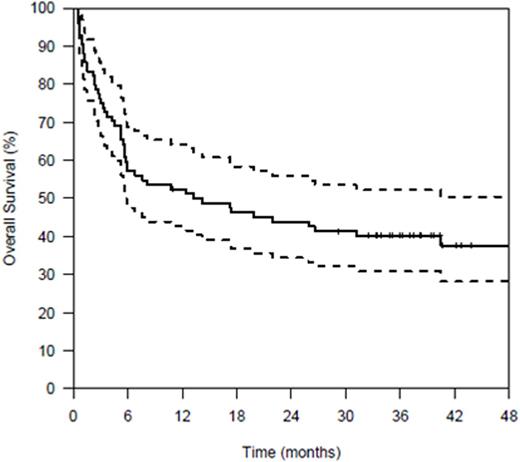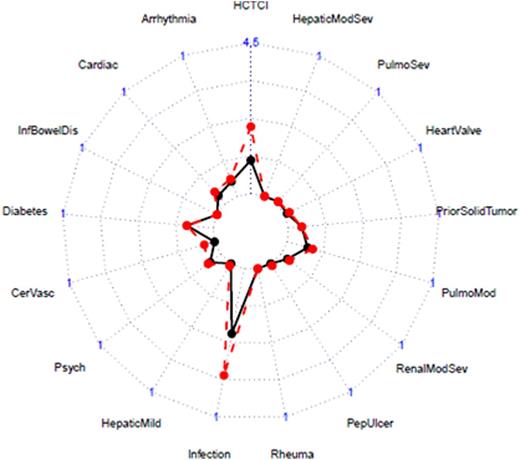Abstract
In patients with relapsed or refractory (r/r) Acute Myeloid Leukemia (AML), allogeneic Hematopoietic Stem Cell Transplantation (HSCT) is considered to be the only treatment providing long-term disease control for fit patients. The BRIDGE trial studied the safety and efficacy of a clofarabine-based salvage therapy prior to HSCT in patients with r/r AML. Here, we report the long-term follow up of this Phase II, multi-center, Intent-To-Transplant study and the impact of comorbidity on outcome.
Eighty-four patients with a median age of 61 years (range 40 - 75) were enrolled. Patients were scheduled for at least one cycle of salvage therapy with CLARA (clofarabine 30 mg/m2 and cytarabine 1 g/m2, days 1-5). Chemo-responsive patients with a donor received HSCT after first CLARA. In the event of a prolonged donor search, HSCT was performed as soon as possible. The conditioning regimen consisted of clofarabine 30 mg/m2, day -6 to -3, and melphalan 140 mg/m2 on day -2. The ECOG score, hematopoietic cell transplantation-specific comorbidity index (HCT-CI) and Cumulative Illness Rating scale (CIRS) were obtained at study enrolment as well as prior to HSCT.
Sixty-seven percent of the patients received HSCT within the trial. After a median follow up of 40months (95% CI, 38-49 months), the estimated 4-year OS (Figure 1) for all enrolled patients was 38% (95% CI, 28-50%) and Disease-Free Survival for transplanted patients was48% (95% CI, 36-64%). The CIR at four years was 30% (95% CI, 17-43%) and the NRM 22% (95% CI, 10-33%).Those patients who received an allogeneic HSCT within the trial had a median HCT-CI at the time of study enrollment of 1 (range, 0 - 6) compared to a median of 2 (range, 0 - 6) for those who did not proceed to allogeneic HSCT (p = .17). Corresponding figures for the CIRS were a median of 2 (range, 0 - 9) compared to 4 (range, 0 - 8) (p = .09). The median ECOG score was 1 (range, 0 - 3) in both groups. Compared to the time point of study enrollment, both the HCT-CI as well as the CIRS increased to a median of 2 (observed range of score, 0 - 7) and a median of 4 (observed range of score, 0 - 12), respectively, at the time of start of the conditioning regimen. This was almost exclusively due to an increase in infectious complications (Figure 2). Inmultivariate analysis, both the baseline HCT-CI and the ECOG score had a statistically significant impact with a HR of 1.22 (p = .025) and 1.72 (p = .001), respectively, on OS.
Using a clofarabine-based salvage therapy combined with early allogeneic HSCT we were able to achieve good long-term results for patients with r/r AML. In this cohort, both the HCT-CI and the ECOG score gave prognostic information on OS, showing feasibility of comorbidity evaluation at the time of diagnose of r/r AML.
Middeke:Sanofi: Honoraria. Rösler:Janssen: Consultancy, Other: Travel/Accommodation/Expenses. Thiede:AgenDix: Employment, Other: Ownership. Schetelig:Sanofi: Honoraria.
Author notes
Asterisk with author names denotes non-ASH members.



This feature is available to Subscribers Only
Sign In or Create an Account Close Modal